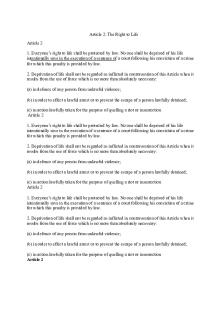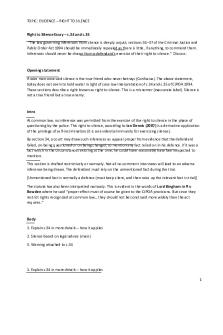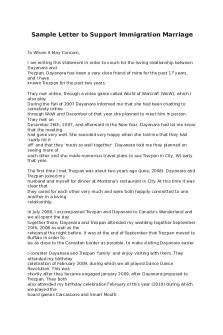Right to Support PDF

| Title | Right to Support |
|---|---|
| Author | Aisyah Ezam |
| Course | Undang-undang Tanah I |
| Institution | Universiti Kebangsaan Malaysia |
| Pages | 5 |
| File Size | 129.1 KB |
| File Type | |
| Total Downloads | 34 |
| Total Views | 152 |
Summary
Notes on right to support...
Description
RIGHT TO SUPPORT 1.0 SECTION 44(1)(b) OF NATIONAL LAND CODE 1965 A land owner has the right to have his land physically supported in its natural state by both adjoining land and underground structures as well as the right not to have that support removed. Section 44(1)(b) of NLC 1965 provides that the right to the support of land in its natural state by any adjacent land, and all other natural rights subsisting in respect thereof. This right of support is a negative right, in which it refers to a right not to lose natural support from the adjoining land this right cannot be interfered by others. It is a duty of the adjacent owner to support and not to do something on his land or property that might endanger the property of others. The neighboring land is expected to obtain support from the adjoining land though it is subject to certain qualifications. In order for a person to have right of support, there are conditions that must be fulfilled. Firstly, the land at the lower level must support the land above it. Secondly, the land must be adjoining with each other, however, the ownership must be separate. Thirdly, the land must be in its natural state in order to be entitled to a right of support from its adjoining land. Fourthly, no additional support is to be given beyond what is on the land such as the owner cannot expect additional support from the adjacent land if his land is proven to be in its weakened state. There are two types of support that one may have right to claim from the adjoining land or building.
2.0 CROSS RIGHT OF SUPPORT FOR ADJACENT LAND/BUILDING
A
B
In this situation, if B’s house suffers damages due to the activities being carried out by A where his right of support from the adjacent building has been infringed, B has a claim against A for damages loss of right of support and vice versa. As an illustration of this basic principle let us suppose two adjoining lot owners, A and B. A has a right to excavate on his lot to any depth providing he furnishes B. With the same lateral support which his land furnished before he started his improvements. For this duty which A, the party changing the nature of his land, owes to B, the adjoining property owner, there is of course the corresponding right of B. To have the lateral support which A’s land gave when in its natural condition. Litigation rises where the land has been improved by the construction of buildings and those buildings are injured as a result of the loss of lateral support when the adjoining landowner excavates on his property preparatory to construction there-on. Where a person adds weight to the soil by the creation of a building, the person thus creating the burden has the duty of providing support from the same. In Madam Chah Siam v Chop Choy Kong Kongsi [1939] 1 MLJ 243, the plaintiff had been in occupation of a large pond on State land, which she used for the purpose of rearing fish. She occupied this pond together with a small pond under a TOL. The defendant occupied the adjoining land, did mining operations until he almost reached the boundary of the bank of the adjoining fish pond. The bank collapsed and water from the pond poured into the mine. The plaintiff claimed for damages, relying on her absolute right to support from the land comprised in the mining lease. It was held that land in its natural state had an absolute right of support from the adjoining lands. Natural state means unburdened with buildings and unweakened by excavations. The pond is simply and excavation cause by mining which has filled up with water. The land in its excavated state is only entitled to such a degree of support as it would have
required in its natural condition; and has no right to the additional support required by reason of its weakened state. In Lembaga Air Perak v. Ding Keng Long & Ors; Pentadbir Tanah Manjung & Anor (Third Party) [2019] 1 CLJ 408, plaintiff is the occupier of a land on which stood reservoirs. The land was leased to the plaintiff by Pengurusan Aset Air Bhd via a lease agreement. The defendant, registered owners of the land next to plaintiff’s land, engaged a contractor to excavate and remove earth from defendant’s land. The contractor commenced the works on defendant’s land upon approval and later received a complaint from the public that the works were too close to the reservoirs. An inspection conducted by plaintiff showed that the slopes on defendant’s lands had created a dangerous situation. Plaintiff commenced an action against the defendant. The defendant subsequently brought third party proceedings against the PTM and the Perak State Government on the ground that it was the PTM that had issued the permit to the contractor for the works. The principle of the case can be seen in the application of S.44(1)(b), where the excavation of red earth carried out by the third defendant on the land of the first and second defendant had resulted in the structure of the slope to be in a dangerous state posing an immediate threat to the safety to the reservoirs.
3.0 SUPPORT FOR ADJACENT SLOPE LAND
A
B In this situation, A has a right of support from B. If B continues with some activities, which may cause soil erosion and collapse of A’s house or structure, B can be made liable to pay damages suffered by A. In the very extreme case, if the owner can prove that the government is negligent in issuing the permit to the owner or occupier of the adjacent land to extract and remove land or rock materials knowingly and willfully that such an action would deprive him of his right of support. Therefore, the government can be held liable instead. Levelling a slope on one’s land may remove lateral support for adjacent land uphill, causing the hill to slide downward and possibly damaging on the adjacent land in the process. A landowner also is entitled to an injunction to prevent removal of naturally necessary support by an adjacent landowner. However, he can negotiate with the adjacent landowners for the right to excavate, but he need to provide the necessary support by artificial means such as retaining walls. In Dalton v Henry Angus & Co [1881] 6 App Ca 740, two dwelling-houses adjoined, built independently, but each on the extremity of its owner's soil and having lateral support from the soil on which the other rested. One of the houses (the Plaintiffs') was converted into a coach factory. More than twenty years after the conversion the owners of the adjoining house employed a contractor to pull down their house and excavate, the contractor being bound to shore up adjoining buildings and make good all damage. The Plaintiffs' stack being deprived of the lateral support of the adjacent soil sank and fell, bringing down with it most of the factory. It was held that the Plaintiffs had acquired a right of support for their factory by the twenty years' enjoyment,
and could sue the owners of the adjoining house and the contractor for the injury. A right to lateral support from adjoining land may be acquired by twenty years' uninterrupted enjoyment for a building proved to have been newly built, or altered so as to increase the lateral pressure, at the beginning of that time; and it is so acquired if the enjoyment is peaceable and without deception or concealment and so open that it must be known that some support is being enjoyed by the building. The principle is that if A owns a plot of land adjoining another plot of land owned by B, and if A erects a house on his own plot of land, after 20 years A acquires a right to whatever support land B gives to his house. If B by excavating land causes A’s house to fall, B is liable to A for damages as are contractors who carry out the work, which results in the damage. However, the principle in Dalton’s case was no longer applicable in Malaysia after the coming of the NLC 1965. The presence of section 44(1)(b) of the NLC 1965 confers the right to support of the land in its natural state by any adjacent land immediately upon disposal and not after 20 years. In Fanuc Sdn Bhd V. Adenland (Cheras) Sdn Bhd & Anor [2020] 5 CLJ 489, it is concerning a suit in trespass and negligence against the defendants in respect of a piece of land in Hulu Langat, Selangor, that belongs to the plaintiff. In substance, the plaintiff’s claim was based on an alleged wrongful removal of earth from and the levelling of its land in the course of the construction of a retaining wall on a road reserve adjacent to it. The alleged wrongful removal of earth resulted in varying reductions in height along the affected parts of the plaintiff’s land. It was held that it was not trespass or damage caused in the execution or conduct of an inherently hazardous activity. What happened here was a conscious act of “cutting down” the Plaintiff’s land and the removal of earth therefrom. Clearly, the 2nd defendant had gone beyond merely building the retaining wall based on the approval by MPKJ. Therefore, judgment was entered against the 2nd Defendant in the sum of RM80,841.78 as special damages and RM500,000.00 as general damages together with interest at the rate of 5% per annum from the date of filing of this action to the date of full realisation and costs....
Similar Free PDFs

Right to Support
- 5 Pages

Right to infomration notes
- 77 Pages

Right TO Information
- 4 Pages

Right to information
- 5 Pages

Right to an Occupation Fee
- 1 Pages

Problem Question Right to Cancel
- 11 Pages

Article 2 Right to Life
- 8 Pages

Art 5 ECHR Right to Liberty
- 6 Pages

Support 01
- 30 Pages
Popular Institutions
- Tinajero National High School - Annex
- Politeknik Caltex Riau
- Yokohama City University
- SGT University
- University of Al-Qadisiyah
- Divine Word College of Vigan
- Techniek College Rotterdam
- Universidade de Santiago
- Universiti Teknologi MARA Cawangan Johor Kampus Pasir Gudang
- Poltekkes Kemenkes Yogyakarta
- Baguio City National High School
- Colegio san marcos
- preparatoria uno
- Centro de Bachillerato Tecnológico Industrial y de Servicios No. 107
- Dalian Maritime University
- Quang Trung Secondary School
- Colegio Tecnológico en Informática
- Corporación Regional de Educación Superior
- Grupo CEDVA
- Dar Al Uloom University
- Centro de Estudios Preuniversitarios de la Universidad Nacional de Ingeniería
- 上智大学
- Aakash International School, Nuna Majara
- San Felipe Neri Catholic School
- Kang Chiao International School - New Taipei City
- Misamis Occidental National High School
- Institución Educativa Escuela Normal Juan Ladrilleros
- Kolehiyo ng Pantukan
- Batanes State College
- Instituto Continental
- Sekolah Menengah Kejuruan Kesehatan Kaltara (Tarakan)
- Colegio de La Inmaculada Concepcion - Cebu






